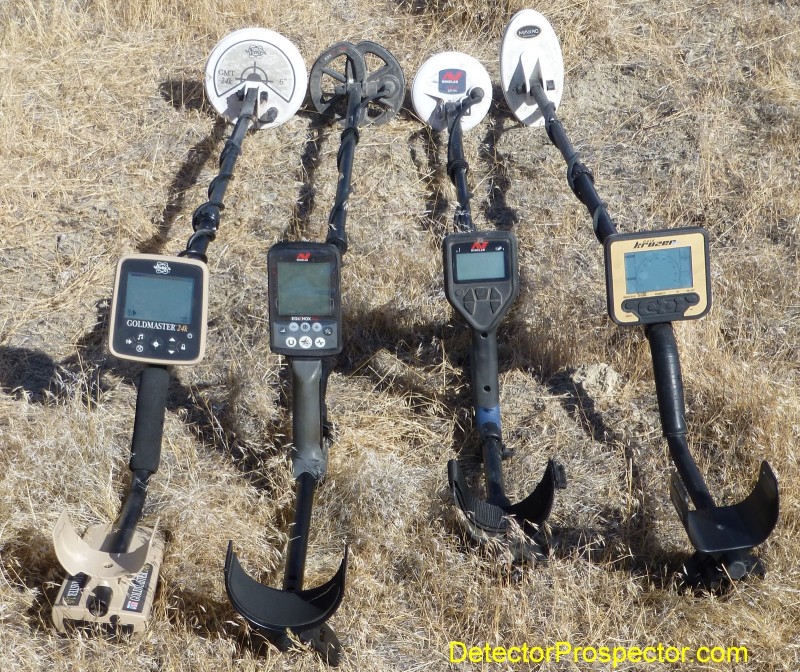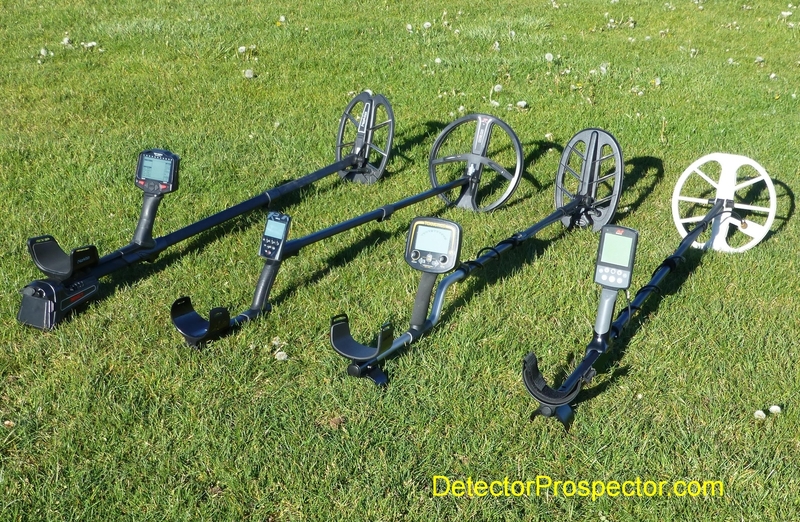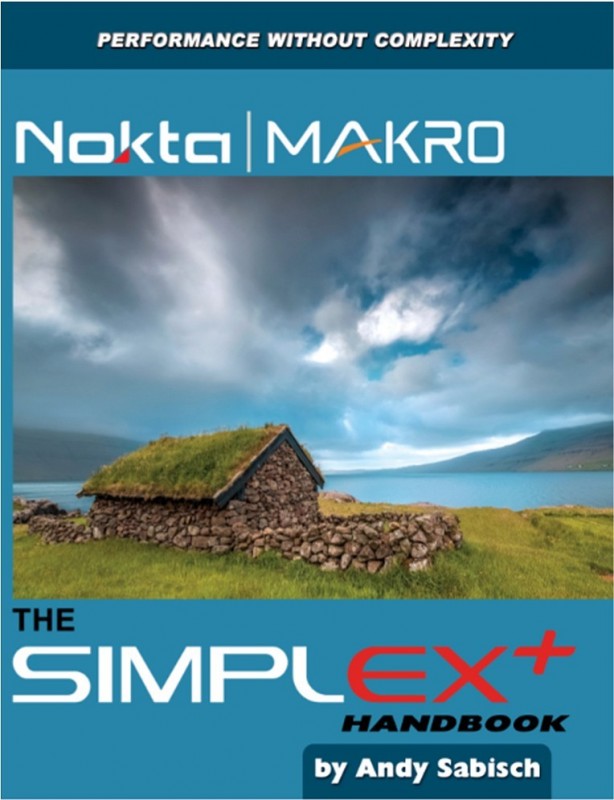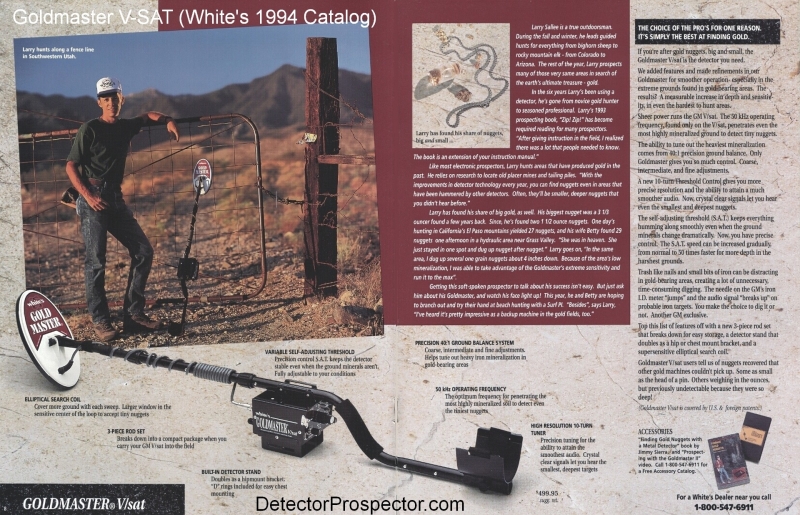-
Posts
19,796 -
Joined
Content Type
Forums
Detector Prospector Home
Detector Database
Downloads
Everything posted by Steve Herschbach
-

Tarsacci - Preliminary Review
Steve Herschbach replied to Chase Goldman's topic in Tarsacci Metal Detectors
Can’t get any more clear cut than that - thanks for the report! -

Gold Kruzer Vs. Gm24k Or GMX Sport
Steve Herschbach replied to Bohemia Miner's topic in Metal Detector Advice & Comparisons
Jeff covers it for me. Of the machines mentioned I prefer the 24K for gold nugget prospecting (GMX is just a waterproof 24K) but the Gold Kruzer for anything else, including in water hunting. -

Minelab Multi I Q Hype?? Watch This
Steve Herschbach replied to Jeff McClendon's topic in Metal Detector Advice & Comparisons
And Multi-IQ does have built in ground handling that makes it less susceptible to the kind of ground conditions that will mess with other detectors that lack a manual ground balance. A person who never ground balances an Equinox will do far better than one might expect, and that carries over into the Vanquish models. The Vanquish 340 being priced at $199 is truly a remarkable amount of power for the money, and in almost all cases will do as well as the Vanquish 540 if outfitted with the same coil. Which in turn is neck and neck with Equinox on most targets. -

Minelab Multi I Q Hype?? Watch This
Steve Herschbach replied to Jeff McClendon's topic in Metal Detector Advice & Comparisons
Mineralization differences mess with a lot of people. Person reads a detector easily hits a dime at 10”. Gets detector, can only hit dime at 6” where he is. Detector defective! Tester was lying!! But it was the mineralization. Not only does mineralization reduce performance, but it does so at different rates with different machines, depending on frequency and ground balance efficiency. Test results for all machines tend to compress at extreme mineral levels, so machines that have a two inch difference in mild soil, may only have a half inch difference in bad ground. Or results can flip entirely, with machines that do exceptionally well in mild soil, performing the worst in bad ground. I was doing a lot of tests like this three years and more ago with Equinox. Good stuff Jeff! -
I’ve got one, have not used it lately so no finds to report.
-

Metal Detecting Depth
Steve Herschbach replied to Martini_Meow's topic in Metal Detector Advice & Comparisons
It’s possible depending on how large the item actually is, and the detector used. How Deep Can I Detect Coins & Relics? -
Welcome to the forum Bill. Sounds like we tread a lot of the same ground!
-
This guy finds a lot of deep silver with a GPX 5000 - Check It Out More Here
- 26 replies
-
- garrett atx
- minelab gpx
-
(and 1 more)
Tagged with:
-

Forrest Fenn Treasure Was Found In Wyoming
Steve Herschbach replied to Glenn in CO's topic in Detector Prospector Forum
The latest..... Man Damages Yellowstone Cemetery Hunting for Forrest Fenn Treasure “A Utah man accused of digging in Yellowstone National Park while looking for the Forrest Fenn treasure faces two federal charges, prosecutors said. The treasure, a chest containing jewelry and gems, was hidden by an art collector a decade ago, with seekers trying to decipher clues left in a book he wrote before it was found in June.” -

Latest Garrett Searcher Newsletter
Steve Herschbach replied to Steve Herschbach's topic in Garrett Metal Detectors
October issue is up.... https://garrett.com/sites/default/files/pdf/2020-10/3500090_October_2020.pdf -

Equinox 800 Gold Nugget Detecting Tips
Steve Herschbach replied to Steve Herschbach's topic in Minelab Equinox Forum
My explanation was not aimed at anyone, just generic stuff. Your case is special Simon in that you are using the disc to eliminate certain pesky non-ferrous items. This can be helpful. I have been places where people have fired off thousands of rounds of .22 bullets, and being able to knock out the shell casings can be a neat trick. Yes, a large nugget that reads the same as a .22 shell casing will be missed, but the odds of that are low, whereas the odds of digging the one thousand shell casings is 100%. The same for you and certain pellets, or any constantly reoccurring trash or hot rock item. Rejecting anything always has risks, but it is all we have for working really trashy locations. -
That's what anyone should be doing all the time. Selling a claim is not miners mining miners. It's not a "flip" or any other derogatory term you want to come up with for a legal activity. That implies there is something wrong with the practice. It's perfectly legal to stake claims, and perfectly legal to sell them. How the claim came about does not matter, all that matters is whether it is valid and current. Further, it's not about respect per se, though that is a nice sentiment. Detecting on a mining claim without permission of the owner is mineral trespass and possible theft, and can have legal consequences. It's not just being nice, it's keeping out of genuine trouble. From More Info on Highgrading and Rye Patch" "This is disturbing to me Mitchel. I made that map and all it shows is who the land manager is and which sections have claims. The simple fact that the BLM is the land manager does not mean the land is open to prospecting or claim. I took the next step for you. I downloaded the Master Title Plat (MTP) for that Township with a click on the Land Status map. The MTP clearly shows that most of the the odd numbered Sections have restricted minerals - as in not yours. So no you can't just look at a simple map and say to yourself "hmmm no claims and it's BLM managed so I'm good to go". The reason this is disturbing to me is myself and others have spent a lot of personal time and money providing free tools and tutorials so the average prospector/researcher can know how to do their legally required Due Diligence before they put boots on the ground. The tools and information are now freely available. Abdicating your personal responsibility to know the land status before you prospect because I provided a map of claimed areas was not the intent of my work. Please don't use Land Matters as an excuse for criminal behavior. Ignorance is never a defense against a prosecution for mineral trespass or mineral theft. The talk here has been of "Claim Jumping". Claim Jumping is the act of trying to steal a mining claim with paperwork and lawyers. Taking minerals from a claim you don't have permission to prospect is highgrading - not Claim Jumping. Higrading in all cases involves the theft of minerals owned by someone else. Apples and Oranges. I get correspondence from a lot of claim owners complaining of higraders. This is not new to mining. Several studies of commercial placer mines have shown that higrading is the biggest threat to a profitable operation. Anyone that has worked for the larger mining companies know they spend a lot of time, money and hours ensuring their minerals are not stolen. Higrading is on every mining companies radar. I often hear excuses like "If the claim isn't marked it's OK to prospect" and the even more common "It's the claim owners responsibility to maintain signs". Neither is true, a few States require corners be checked on an annual basis but in point of fact most states have no legal requirement that claims must maintain markers. In several states corner markers are not required at all for some claims and monuments only have to be present at the time of location. Although as a practical matter the claim owner should do everything possible to put others on notice of the claim it is not the legal responsibility of the claim owner to use signs or markers to keep prospectors off their claim. Prospectors, unlike the general public, have a positive legal duty to know the mineral status of the land before entering to prospect. The claim owner put other prospectors on legal notice when they recorded their "Notice of Mining Claim Location" into the public record. That public record suffices as proper notice under the law even if there are no stakes at the mining claim location. The public record is open for inspection to all people. Potential prospectors need to examine the public record before entering the land to prospect. Land Matters provides links to all the County Recorders right on the Mining Claim maps to assist you in accomplishing that requirement. Where Land Matters could do better is in providing the subsurface mineral status of the lands. As you've seen above not all BLM managed land is open to prospecting or location. It's not just a matter of mineral withdrawals but more subtle issues like those odd numbered sections in parts of Rye Patch that were reconvened and were never open to location. There was no withdrawal there because there were no mineral rights to withdraw. Often those minerals have already been sold or leased. If you are found extracting minerals from these restricted lands the BLM will bring charges of criminal mineral theft. It happens quite often and is frequently prosecuted for something as simple as taking a pickup load of gravel or sand. Then there is the big mass of "dark matter" that is the subsurface estate still owned by the United States. There are nearly 7 million acres of mineral lands, often available for prospecting and location, underneath private lands in the west. Mining companies know this and have legally mined private lands for years. It requires a huge amount of research to determine just where these hidden mineral lands are found. The BLM is tasked with maintaining the records of this huge subsurface estate but between the BLM and mining companies the attitude seems to be "out of sight - out of mind". With very few exceptions these records are available but virtually unobtainable by the average researcher. Land Matters has plans to map these subsurface mineral rights but it's a huge project with little public interest beyond the landsmen and oil and gas industries. We need to see some real public interest before we will commit the resources needed to complete such a big project. Now to the tough part. Most of these complaints I receive of higraders are about metal detecting. Rarely do I hear of processing equipment being used. At least 9 out of 10 reports of higrading I receive are about metal detectorists taking the best and biggest gold. Several of you on this forum have been named by claim owners. I'm not the enforcement guy and I will not be calling you out in public but I do know. For small miners trying to protect their owned minerals from higrading the pointy finger is mostly about metal detectorists. I do know that few of you set out with the intent to detect someone's minerals. In most cases these violations are due to ignorance, intentional or otherwise. Assuming that signs are required or that unclaimed BLM managed land must be available for prospecting are just two examples. I have heard from many prospectors that the big mining companies (or someone who appears to be working for a mining company) allow prospectors to work their claims. I've never found a prospector who had a name, phone number or signed release but this seems to be one of those things "everyone knows". I can tell you that no mining company that has public shares could ever legally allow you to prospect their claims without a work contract. The simple fact that you haven't been caught or run off does not amount to permission. Please learn to do your own due diligence. Please respect mineral owners rights, those minerals are their private property under the law. With a little luck and hard work you could own a good deposit yourself. Barry"
-

Golden Mask Telescoping Shaft Rebuild
Steve Herschbach replied to Steve Herschbach's topic in Minelab Equinox Forum
The adapter was given to me to use on my original Golden Mask setup, and the armrest is from the same Golden Mask setup. The one I ran over and broke, prompting this rod replacement. It’s all detailed in the reference links in the original post in this thread. I’ve also used simple hose clamps, and the armrest for other detectors by fashioning an adapter end piece. Again, it’s all in the reference threads. -

Equinox 800 Gold Nugget Detecting Tips
Steve Herschbach replied to Steve Herschbach's topic in Minelab Equinox Forum
It just depends on the trash levels. Rule number one of nugget detecting - dig absolutely all targets. But if you can’t realistically do that, you start skipping the ones with the worst signals. But it is always a gamble with small signals in highly mineralized ground. The more ground iron mineralization, the more chance a weak non-ferrous signal will read ferrous. Here is how that works. Get a very faint signal, consistently ferrous on every sweep. Obviously ferrous, no question. Now remove a little soil. At some point the target reads both ferrous and non-ferrous, erratic. Remove a little more soil. Now it’s a fairly consistent non-ferrous signal. The detector sees both the gold signal, and the ferrous ground mineral signal. It tells you which signal dominates, and that may very well be the ferrous component. Consistency only tells you that the machine is consistently accurate, or consistently inaccurate in its reporting. It’s like a spectrum, with a pure ferrous reading on one end, pure non-ferrous reading on the other, and every possible inconsistent reading in between. It just depends on how much and how intense the interference from the mineralized soil. The IS NOT an Equinox issue, this applies to all detectors, especially single frequency detectors. Equinox has enough controls plus Multi-IQ to do better than most. More Details Here Like I said, rule number one is dig everything. This is how you learn that a ferrous reading can be a non-ferrous item. If you can’t dig everything, dig anything that gives any non-ferrous reading at all, even just once out of several swings. If that’s too much digging, then ramp it up to dig only solid non-ferrous readings. It’s like a sliding variable scale, determined by how much time you have, and how strong your back is. -

Gp Extreme With Two 18650 Batteries
Steve Herschbach replied to bklein's topic in Minelab Metal Detectors
You cannot fry any detector detecting manhole covers or even aircraft carriers. At least not if they are functioning properly. -

Minelab Go-find 66 Makes You Rich
Steve Herschbach replied to Gold Catcher's topic in Minelab Metal Detectors
Not a big deal. People make money on YouTube posting dancing cats and UFO videos... you name it. I am unaware of any requirement that any of it has to be real. The people paying all the bills are the advertisers sponsoring the videos. It’s not like you, the viewer, is paying money to watch. I was wondering if they use the same gold in any of the videos, but my desire to watch expires in minutes, so I just don’t know. -

Minelab Go-find 66 Makes You Rich
Steve Herschbach replied to Gold Catcher's topic in Minelab Metal Detectors
They may be fake, but it's working. This is at least the third thread linking to and about these people digging giant chunks of gold with toy detectors and toy digging tools. All that gold, you'd think they could afford better gear! But they are getting the last laugh. Based on the channel viewership, they are minting their own gold getting people to watch this stuff. There is the more recent thread Simon posted. Here is one from Jan 2019. There is another one that went for pages of commentary, but I was not lucky enough to find it with a quick search. -
Announcing the Nokta|Makro Simplex+ Handbook We are proud to announce that Andy Sabisch’s latest book - The Nokta|Makro Simplex+ Handbook – will be available shortly. The new book covers all aspects of Simplex+ including a discussion of all its functions and features, tips on getting the most out of it under virtually any condition you might come across, details on a range of applications including coin hunting, relic hunting, field and pasture hunting, beach and water hunting with invaluable information provided by some of the top Simplex+ users from around the globe, useful accessories, available resources and more. Since the introduction of the Simplex+ at Detectival in September of 2019, it has taken the world by storm due to the performance it provides and its price tag. Users worldwide have been making amazing finds at sites that include fields, woods, beaches, parks, schoolyards and mountains. Coins, relics, jewelry and other artifacts dating back 1,000s of years are being found regularly with even newcomers to the hobby making impressive finds with the Simplex+. This book is the perfect companion to a detector that has proven itself to be a powerful piece of equipment. It will serve as an easy reference guide which will have information for even the most seasoned hunter which means more finds at the end of the day and more enjoyment in the time available. The book measures 8.5” x 11” and contains 112 pages. The expected release is mid-October and pre-orders for signed copies in the U.S. are being accepted. If you are located outside of the United States, check with your local Nokta|Makro distributor to see if they are lined up to carry them. Regton in the U.K. will be carrying the book for both retail and wholesale customers. If you are in the United States contact me at Treasure Hunting Outfitters for your signed by the author Pre-order copy of the book.
-
Both detectors are basically the same, and have not been made in over 20 years. If I had to use one it would be the newer V/SAT, but reality is I have the newest Goldmaster 24K. The Goldmaster II in 1990 was the first of the new "black box" 50 kHz Goldmaster series. There was an old Goldmaster series in blue boxes that used old TR technology and which should not be confused with the newer ground balancing units. List price new for the GMII was $499.95The Goldmaster II was replaced by the Goldmaster V/SAT in 1994. The Goldmaster V/SAT added the "Variable Self Adjusting Threshold" control that gave the model it's name. The V/SAT also had a list price of $499.95The Goldmaster 3 added an audio boost feature and was the last model that was convertible to chest or hip mount. The GM3 also introduced the DD coil still used on the Goldmasters to this day. The Goldmaster II and V/SAT had a concentric coil. List price was $599.95. The Goldmaster 4/B introduced the new coin detector style box. List price was bumped to $699.95. The price increase and new box design were not well received. The 4/B was therefore not very popular and is rarer than the other models. It was also available in a rather clunky chest mount only version.All these models offered essentially the same 50 kHz performance. The new Goldmaster GMT is a total redesign with digital processing, a refined iron id system, and most importantly, the option to either manually ground balance or auto ground balance. The operating frequency was shifted slightly to 48 kHz so as to not interfere with previous Goldmasters in the field. The ability to auto ground balance is a real boon to new users, while the ability to manually tune is a plus for the professional. Most other units on the market let you do one or the other, but not both. The GMT has been a very popular unit. List price is $799.95 Even though the GMT is 48 kHz and the prior models are 50 kHz, the coils are compatible with all these models. The Goldmaster 24K coils are not compatible with other Goldmaster coils. Starting about 1990 the sequence was: White's Goldmaster II (1990) - new 50 kHz model, on S rod with removeable control box. White's Goldmaster V/SAT (1994) - added Variable Self Adjusting Threshold (V/SAT) control, on S rod with removeable control box. White's Goldmaster 3 (1996) - Added frequency offset, boost options, three piece rod standard (optional in previous two piece models), on S rod with removeable control box. Widely considered the best analog Goldmaster. White's Goldmaster 4/B (1998) - Added meter on a pod for iron discrimination, non-removable coin detecting type box design. White's GMT (2000) - Completely new 48 kHz microprocessor model, non-removable coin detecting type box design. White's Goldmaster 24K (2018) - Another completely new design, based on MX5 circuit board. New 24K coils are not compatible with prior Goldmaster models.
-

Minelab Part Question? What Is This Piece
Steve Herschbach replied to idahogold's topic in Minelab Metal Detectors
Any links? -
I admit it is a quandary at times. If nobody ever showed finds forums and such would get pretty dull. On the other hand it can attract unwanted attention. I go out of my way to note I have no gold or other serious valuables in my house, but I worry somebody might come looking anyway. Kind of like the time my locked truck that had nothing in it got broken into. Nothing was stolen, but I still had a side window to replace.
-
These claim owners care.....
-

Gigmaster With The AQ
Steve Herschbach replied to vive equinox's topic in First Texas - Bounty Hunter, Fisher & Teknetics
The Impulse is a pulse induction metal detector, and will therefore find plenty of trash. Frankly, this has been discussed at great length and detail in previous threads. I suggest you spend time reviewing older Impulse threads here by the people who are using them. This will show you what people find in average hunts. All Fisher Impulse AQ threads




